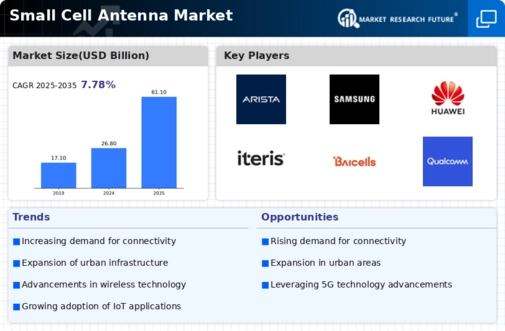Support for 5G Network Rollout
The ongoing rollout of 5G networks is a pivotal driver for the Small Cell Antenna Market. 5G technology promises significantly faster data speeds, lower latency, and the ability to connect a vast number of devices simultaneously. Small cells play a crucial role in this transition, as they enable operators to densify their networks and provide coverage in areas where traditional infrastructure may be insufficient. Industry estimates suggest that by 2025, the number of small cells deployed could exceed 5 million globally, underscoring their importance in achieving the ambitious goals set for 5G deployment. This proliferation of small cells is likely to enhance overall network performance and user satisfaction.
Integration with Smart City Developments
The integration of small cell antennas with smart city developments is emerging as a significant driver for the Small Cell Antenna Market. As cities evolve to incorporate advanced technologies, the demand for robust communication networks becomes critical. Small cells facilitate the deployment of various smart city applications, including traffic management, public safety, and environmental monitoring. By providing the necessary connectivity for Internet of Things (IoT) devices, small cells support the infrastructure required for these initiatives. As urban planners increasingly prioritize smart city projects, the small cell market is likely to expand, with projections indicating a compound annual growth rate of over 20% in the next few years.
Rising Demand for Enhanced Mobile Connectivity
The Small Cell Antenna Market is experiencing a surge in demand for enhanced mobile connectivity. As consumers increasingly rely on mobile devices for communication, entertainment, and business, the need for reliable and high-speed internet access becomes paramount. This trend is particularly evident in densely populated urban areas, where traditional macro cell towers may struggle to provide adequate coverage. According to recent data, the number of mobile subscribers is projected to reach over 5 billion by 2025, further driving the need for small cell solutions. These antennas facilitate improved network performance, reduce latency, and enhance user experience, making them essential for mobile network operators aiming to meet consumer expectations.
Growing Adoption of Internet of Things (IoT) Devices
The proliferation of Internet of Things (IoT) devices is a key driver for the Small Cell Antenna Market. As more devices become interconnected, the demand for reliable and high-capacity networks intensifies. Small cells are particularly well-suited to support the dense connectivity requirements of IoT applications, which often involve numerous devices operating in close proximity. Industry forecasts suggest that the number of connected IoT devices could reach 30 billion by 2025, creating a substantial need for small cell infrastructure to manage this growth. This trend not only enhances network efficiency but also opens new avenues for service providers to offer innovative solutions tailored to the evolving needs of consumers and businesses.
Increased Focus on Network Reliability and Resilience
In an era where connectivity is critical, the Small Cell Antenna Market is witnessing an increased focus on network reliability and resilience. Businesses and consumers alike demand uninterrupted service, particularly in high-traffic areas. Small cells offer a solution by providing localized coverage that can alleviate congestion on macro networks. This is particularly relevant in urban environments, where the density of users can lead to network strain. As organizations invest in infrastructure to ensure consistent connectivity, the adoption of small cell technology is expected to rise. Market analysts indicate that the small cell segment could account for a substantial portion of the overall telecommunications infrastructure investment in the coming years.
















Leave a Comment